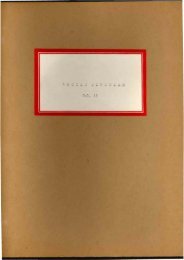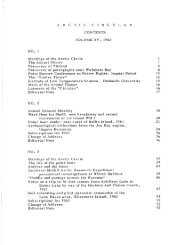Volume 4, 1951 - The Arctic Circle - Home
Volume 4, 1951 - The Arctic Circle - Home
Volume 4, 1951 - The Arctic Circle - Home
Create successful ePaper yourself
Turn your PDF publications into a flip-book with our unique Google optimized e-Paper software.
<strong>The</strong> primitive weapons of stone age man were adequate for his<br />
needs and, \vhen game was available, he was able to secure<br />
sufficient food and clothing. Because hunting was laborious<br />
and the making of arrowheads and spear points difficult and<br />
time-consuming, more game was rarely killed than was needed<br />
for the hunter and his family. Although in the <strong>Arctic</strong> the<br />
balance between natural increases and predation was often a<br />
delicate one, the vicissitudes to which hunting tribes have<br />
always been prone were, perhaps, more frequently caused by<br />
changes in the migration routes of game animaIs than by excessive<br />
predation. <strong>The</strong> introduction of firearms progressively<br />
changed this picture and, as regards some large land animaIs,<br />
there has been a rapid, and in some parts catastrophic,<br />
decrease in numbers. Again, depending on differences in the<br />
hysiography of the area, the impact of changed hunting methods<br />
as affected different game animaIs in different ways. ln the<br />
ften precarious existence of Eskimo and Indians, caribou have<br />
lways been important. To some tribes caribou has aotually<br />
een the "staff of life" and its disappearance has often meant<br />
tarvation and death.<br />
Estimates of animal populations are frequently subject<br />
o errors of judgment and sorne early estimates of the numbers<br />
f barren ground caribou should be accepted with reservation.<br />
ie do know, however, from the accounts of early travellers<br />
hat caribou were once plentiful from Bering Strait to the<br />
coast of Labrador. We know, also, that at present caribou<br />
re scarce or have altogether disappeared in muny areas where<br />
hey were plentiful only a few decades ago. hlthough concern<br />
ver this has long been felt in responsible quarters, no<br />
anacea has ever been proposed. ln Alaska, and later in<br />
anada, attempts have been made to introduce domesticated<br />
eindeer to ease the drain on the wild caribou population or<br />
to provide a substitute in places where caribou had already<br />
disappeared. Thus far these experiments have met with only<br />
artial or indifferent success, because reindeer nomadism<br />
18 incompatible l'vithpresent trends of cultural development<br />
and because the North American <strong>Arctic</strong> is too thinly populated<br />
to provide a ready market for reindeer products. One of the<br />
most constructive steps taken in Canada toward the preservation<br />
of the remaining caribou herds has been the "caribou<br />
survey" which for sorneyears has been conducted by'mammalogists<br />
of the Canadian vHldlife Service (Banfield, 1950).<br />
Thus far this survey has been concerned largely with the<br />
continental parts of Keewatin and Mackenzie where very large<br />
herds still existe It is hoped that, in addition to fairly<br />
reliable estimates of the present caribou population, the<br />
survey "viII determine the relation between natural annual<br />
increases .and predation, for only when this has been done












